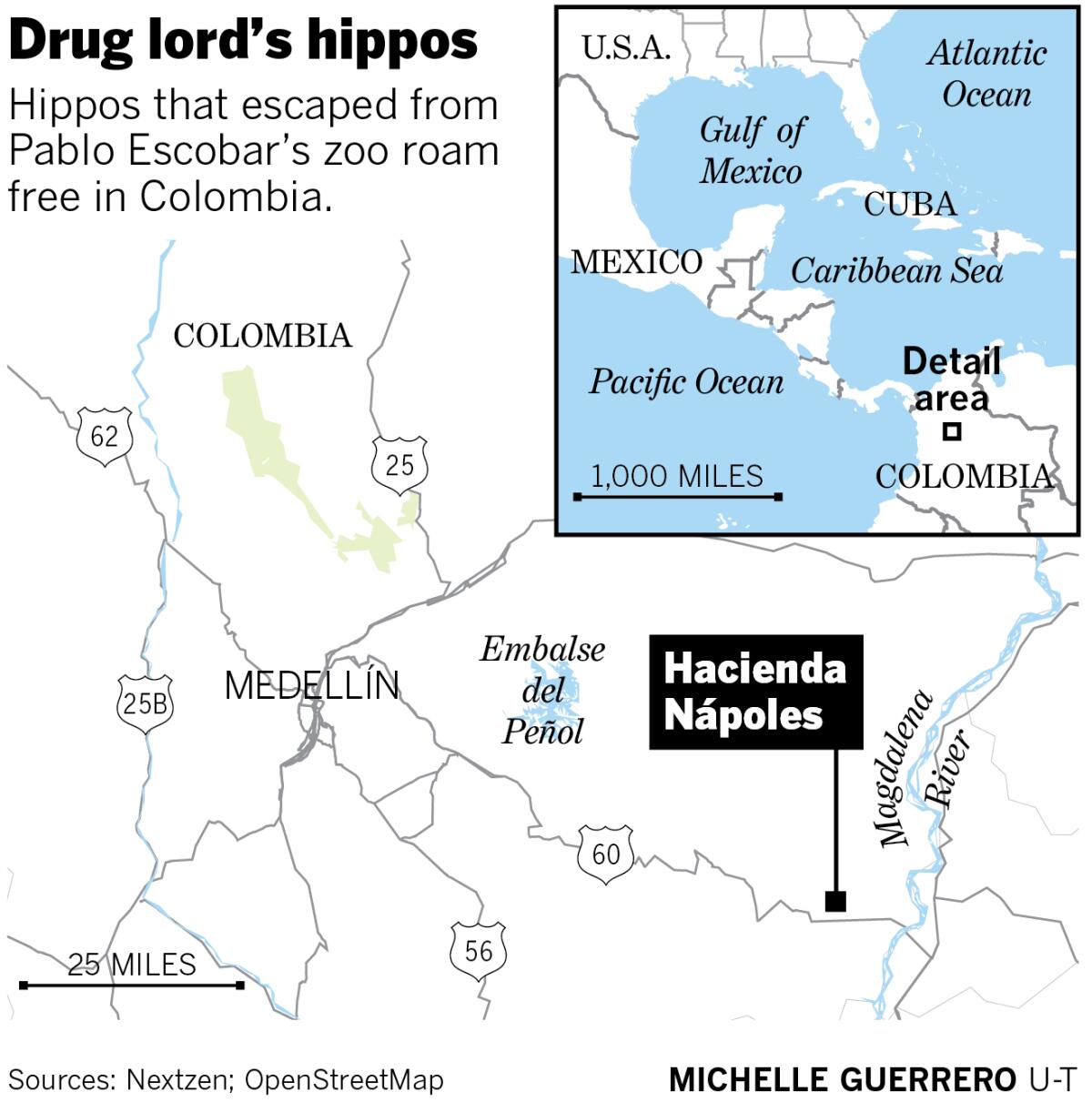Chasing Colombia’s ‘cocaine hippos’
- Share via
SAN DIEGO — Even at Hacienda Nápoles, the hippos stood out.
Given the marvels of Pablo Escobar’s 7,400-acre central Colombian hideaway, that was no small feat. The notorious drug lord’s $63-million ranch had its own airport and heliport. Man-made lakes. Life-size dinosaur statues. A fleet of collectible cars. A zoo filled with elephants, rhinos, giraffes, rare tropical birds and other exotic beasts.
And still, people noticed the hippos.
For good reason, said Jonathan Shurin, a UC San Diego biologist: “These are large, charismatic animals.”
They are also among nature’s prima donnas, requiring careful handling. After the Colombian National Police killed Escobar in 1993, zoos and private collectors acquired the animals, all except the hippopotamuses.
Wallowing in the Magdalena River, they were too unwieldy, too dangerous, to move. In time, they escaped from the compound and wandered into the Colombian countryside.
They remain there today, the only hippos in the wild outside Africa.
Escobar started with four hippos. When Shurin obtained a National Geographic grant to study this pod in 2017, the population had swollen to about 65.
Today, he estimates there are 80 to 100.
“In 20 to 40 years,” he said, “there will be thousands.”
Working with biologists from the Universidad Pedagógica y Tecnológica de Colombia and a UC San Diego post-doctoral student, Natalie T. Jones, Shurin is measuring the hippos’ impact on their new realm. During his expeditions, he learned much about the so-called cocaine hippos.
For instance: “You know how people say about wild animals ‘if you don’t bother them, they won’t bother you,’ and ‘they’re more afraid of you than you are of them’?” Shurin asked.
“Neither is true of hippos.”
Hasty retreat
For centuries, these creatures have captured the human imagination. Plush hippo toys are found in the cribs of modern-day infants, while 4,000-year-old ceramic hippo figurines taken from Egyptian tombs are displayed in the Louvre. There are songs (“I Want a Hippopotamus for Christmas”), children’s books (“George and Martha,” “Hippos Go Berserk!”) and cartoons (“Hugo the Hippo”).
For all their popularity, hippos are often misunderstood. The name derives from the Greek “river horse,” yet hippos are not an equine species. Nor are they related to pigs, as earlier scholars argued; instead, current research links them to the cetacean family.

“Hippos,” Shurin said, “are the closest terrestrial animals to whales.”
Another misconception: These are cuddly critters.
“River hippos are pretty violent by nature,” said Jennifer Chapman, a senior mammal keeper at the San Diego Zoo. “They have short fuses.”
Shurin, a Cleveland native who has taught at UC San Diego since 2010, is an expert on water resources and quality. Although this was his introduction to wild hippos, he’s no stranger to Colombia, having conducted an earlier research project at Lago de Tota, the South American nation’s largest lake. He was surprised and intrigued when he heard about Pablo Escobar’s enduring natural legacy.
“That’s too good to pass up,” he decided. “This is a bit of a window into the past.”
Mammoths, land sloths and other large mammals that once roamed the Americas died out about 12,000 years ago. What would happen if an animal of similar size were reintroduced to this environment?
“The closest thing to hippos in the Americas now are tapirs,” Shurin said. “We’ve never had hippos.”
So he journeyed south to Hacienda Los Nápoles, about 80 miles outside Medellín, sitting in a valley on the edge of a tropical rain forest. Hot and humid, the mercury regularly climbing past 100 degrees, the land swarms with life: monkeys, macaws, iguanas. Swimming in the rivers are manatees, giant turtles, caimans.
Asian water buffaloes also have been imported, to work on the plantations that fuel the palm oil trade, but they don’t roam free like the hippos. Nor do they pose the same sort of danger — territorial animals, hippos have been known to rush people who stray too close. During one of his four trips to the area, Shurin was in a power boat observing hippos when the animals charged. He hastily retreated.
That was wise, noted the zoo’s Chapman, who works with hippos.
“The river hippo is responsible for the most deaths in Africa,” Chapman said. “And they are fast. People don’t understand that.”
Up to 16 feet in length and 5 feet tall, weighing up to 4 tons, these beasts can reach speeds of 25 mph on land. Although they don’t swim — Chapman noted they actually run on riverbeds — they are deceptively swift in the water. “There are these amazing videos taken from boats,” she said, “you see this wave, this ripple on the water, and all of a sudden they show in slow-mo this huge animal coming out of the water.”
Hippos kill roughly 500 people a year in Africa, making them twice as lethal as lions. So far, there have been no reported deaths in Colombia.
“The locals seem fairly nonchalant about them,” Shurin said. “It’s like, ‘Yeah, we see them, but we go about our business.’ ”
‘Organic material’
Nocturnal by nature, the Colombian hippos eat large quantities of grass, grazing all night and every night.
“They only eat on land,” Shurin said. “Then they come into the water and crap all day.”
In a paper published in the journal Ecology, Shurin, Jones and their Colombian colleagues used another term for the waste hippos sprayed into the water. This “organic material,” as they called it, fuels algae blooms, alters oxygen levels and may lead to fish die-offs. If the hippo pods continue to grow at their current pace, there’s also the danger that they’ll deplete local grasslands.
At present, though, there is no strategy to keep this population in check. Colombian officials told Shurin there was no money to fund a sterilization campaign, and the locals are opposed to culling the herd.
“Within Colombia, there’s resistance to killing them,” Shurin said. “People like that they attract tourists. And people like animals.”
So far, there’s only a minor amount of hippo-related tourism. Shurin noted some Colombians venturing into this region, eager to spot these beasts, but he didn’t see any foreigners. There are no organized semi-aquatic safaris, although one restaurant has opened on a shoreline overlooking a popular hippo wading area.
Among researchers, there’s no clear consensus on whether this invasive species will benefit or harm the local environment.
Around Hacienda Nápoles, Shurin, Jones and their Colombian colleagues took water samples from 14 small lakes, two with hippo populations and 12 without.
“The effects of hippos on the aquatic environment that we observe,” the researchers wrote in the journal, “suggest that sustained population growth poses a threat to water quality in lakes and rivers as they expand their range throughout Magdalena Medio watershed and potentially colonize new regions on the Caribbean slope of Colombia.”
Yet some biologists speculate that the, ahem, nutrients the hippos dump into the waterways may help other species flourish, expand Colombia’s wetlands and prevent the encroachment of grasslands.
Escobar’s ranch is now a popular amusement park, even though the late drug lord remains controversial in Colombia. The multibillion-dollar cocaine trade sparked open warfare in cities and rural areas. Judges and politicians were routinely assassinated, and many innocent Colombians were caught in the crosshairs. Among the casualties was a tourist industry, which is just starting to recover.
“Colombia is gorgeous,” Shurin said. “It is an amazing place to go.”
There’s so much to see: sparkling beaches, snowcapped Andean peaks, rainforests, picturesque lakes. And, at least for the foreseeable future, a rare South American glimpse of African wildlife.









